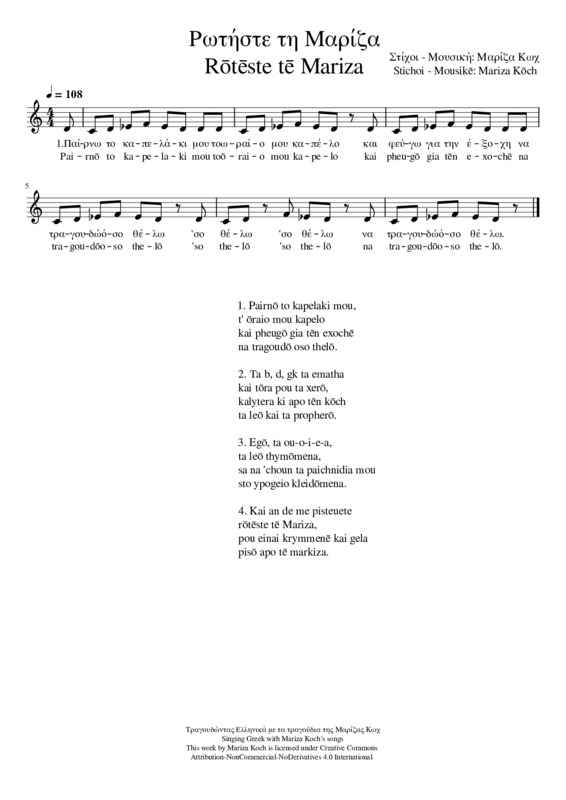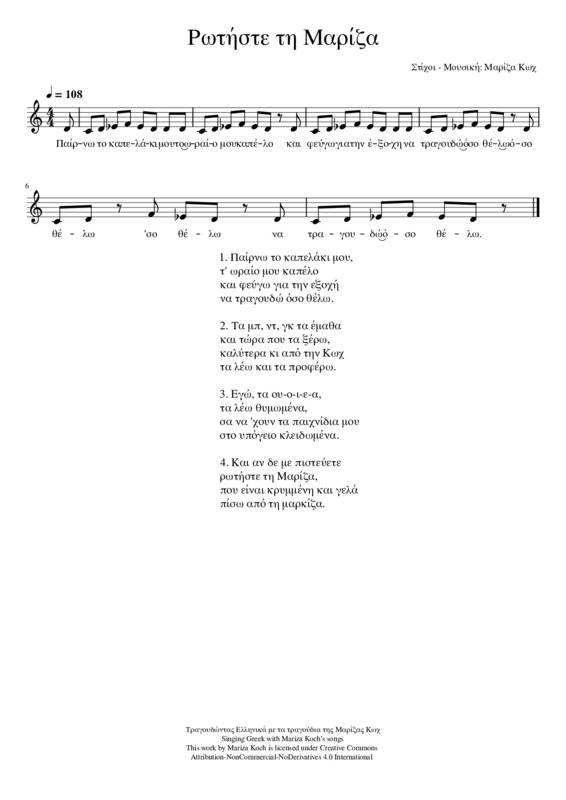
Rōtēste tē Mariza

Rōtēste tē Mariza
Pronunciation
Articulation of the phonemes /μπ/ (/b/ or /mp/, /b/ when the consonants are at the beginning and /mp/ when in the middle or the end), /ντ/ (/nt/) and /γκ/ (/gk/ or /nk/, /gk/ when the consonants are found at the beginning or at the end of the word, and /nk/ when in the middle) and their use in Greek language [μπακάλης (bakalēs, grocer), ντομάτα (ntomata, tomato), γκρεμός (gkremos, cliff), etc.].
Find other words in Greek containing these phonemes.
Repeat and articulate well the vowels: /ου/, /ο/, /ι/, /ε/, /α/ (/ou/, /o/, /i/, /e/, /a/).
Change the vowels: replace the vowels of some of the lyrics with a specific vowel each time, i.e. ρατάστα τα Μαράζα, πέρνε τε κεπελέκε με (ratasta ta Maraza, perne te kepeleke me).
Find other words in Greek containing these phonemes.
Repeat and articulate well the vowels: /ου/, /ο/, /ι/, /ε/, /α/ (/ou/, /o/, /i/, /e/, /a/).
Change the vowels: replace the vowels of some of the lyrics with a specific vowel each time, i.e. ρατάστα τα Μαράζα, πέρνε τε κεπελέκε με (ratasta ta Maraza, perne te kepeleke me).
Speech Comprehension and Production
Simile: on the occasion of the simile "τα λέω θυμωμένα, σα να 'χουν τα παιχνίδια μου στο υπόγειο κλειδωμένα" (ta leō thymōmena, sa na 'choun ta paichnidia mou sto ypogeio kleidōmena), the pupils create their own similes.
Rhyme: based on the phrase "Ρωτήστε τη Μαρίζα, που είναι κρυμμένη και γελά πίσω από τη μαρκίζα" (rōtēste tē Mariza, pou einai krymmenē kai gela pisō apo tē markiza), the pupils create corresponding rhymes using their names, i.e. Ρωτήστε την Κλειώ, που είναι κρυμμένη και γελά πίσω από το καπώ (rōtēste tē Kleiō, pou einai krymmenē kai gela pisō apo to kapō).
Study the vocabulary: μαρκίζα (markiza, marquee): meaning, use, examples. The pupils make their own marquees in hypothetical shops (work in groups).
Narrative: the pupils, in pairs, express an achievement of their own in a past tense, just like the character of the song, and then they announce it to the other groups in the 3rd person, i.e. Έμαθα να μαγειρεύω μακαρόνια με κιμά... (Ematha na mageireuō makaronia me kima, I've learnt to cook pasta with meat sauce), Ο Θωμάς έμαθε να μαγειρεύει μακαρόνια με κιμά (O Thōmas emathe na mageireuei makaronia me kima, Thomas has learnt to cook pasta with meat sauce).
Rhyme: based on the phrase "Ρωτήστε τη Μαρίζα, που είναι κρυμμένη και γελά πίσω από τη μαρκίζα" (rōtēste tē Mariza, pou einai krymmenē kai gela pisō apo tē markiza), the pupils create corresponding rhymes using their names, i.e. Ρωτήστε την Κλειώ, που είναι κρυμμένη και γελά πίσω από το καπώ (rōtēste tē Kleiō, pou einai krymmenē kai gela pisō apo to kapō).
Study the vocabulary: μαρκίζα (markiza, marquee): meaning, use, examples. The pupils make their own marquees in hypothetical shops (work in groups).
Narrative: the pupils, in pairs, express an achievement of their own in a past tense, just like the character of the song, and then they announce it to the other groups in the 3rd person, i.e. Έμαθα να μαγειρεύω μακαρόνια με κιμά... (Ematha na mageireuō makaronia me kima, I've learnt to cook pasta with meat sauce), Ο Θωμάς έμαθε να μαγειρεύει μακαρόνια με κιμά (O Thōmas emathe na mageireuei makaronia me kima, Thomas has learnt to cook pasta with meat sauce).
Music Activities
Correct placement of lips, tongue and mouth during singing.
Vocal exercises utilizing the vowels "ου-ο-ι-ε-α" (ou-o-i-e-a) and simultaneous use of the movement indicating the changes in pitch, intensity and sound duration.
Counting-out rhymes: "α μπε μπα μπλομ" (a be ba blom), "άκατα μάκατα σούκουτε μπε" (akata makata soukoute be), "εν, ντε, τρουά, φασόλια και κουκιά" (en, nte ,troua, phasolia kai koukia) for practicing consonants, vowels and syllabification.
Take advantage of the pauses during the song: the children, arranged in a circle, sing and clap during the pauses or during the upbeat. They move in space by tapping their feet on the pulse and their hands during the pauses or the upbeat.
Divide the class into three groups. Each group makes its own rhythmic patterns with body percussion or percussion instruments to accompany the song. Play the rhythmic patterns alternately and by combining one another, even when the song is over.
The pupils, sitting in a circle, sing while using an object (stone, hat, pencil, maracas, etc.) to perform body percussion to the child sitting next to them, following the beat of the song. (video)
Vocal exercises utilizing the vowels "ου-ο-ι-ε-α" (ou-o-i-e-a) and simultaneous use of the movement indicating the changes in pitch, intensity and sound duration.
Counting-out rhymes: "α μπε μπα μπλομ" (a be ba blom), "άκατα μάκατα σούκουτε μπε" (akata makata soukoute be), "εν, ντε, τρουά, φασόλια και κουκιά" (en, nte ,troua, phasolia kai koukia) for practicing consonants, vowels and syllabification.
Take advantage of the pauses during the song: the children, arranged in a circle, sing and clap during the pauses or during the upbeat. They move in space by tapping their feet on the pulse and their hands during the pauses or the upbeat.
Divide the class into three groups. Each group makes its own rhythmic patterns with body percussion or percussion instruments to accompany the song. Play the rhythmic patterns alternately and by combining one another, even when the song is over.
The pupils, sitting in a circle, sing while using an object (stone, hat, pencil, maracas, etc.) to perform body percussion to the child sitting next to them, following the beat of the song. (video)
Cross-thematic Connections - Greek Culture
Interdisciplinary concepts: evolution, variation.
View images of shops, theaters and entertainment center marquees from different times, places and cultures. Study the changes in the significance of their cultural content as well as the changes that have arisen as a result of the economic, social and cultural evolution.
View images of shops, theaters and entertainment center marquees from different times, places and cultures. Study the changes in the significance of their cultural content as well as the changes that have arisen as a result of the economic, social and cultural evolution.
Age level
7-11 years old
Language level
Intermediate
Ta chrōmatista tragoudia/ Anekdoto/ Mēlo-rodi





